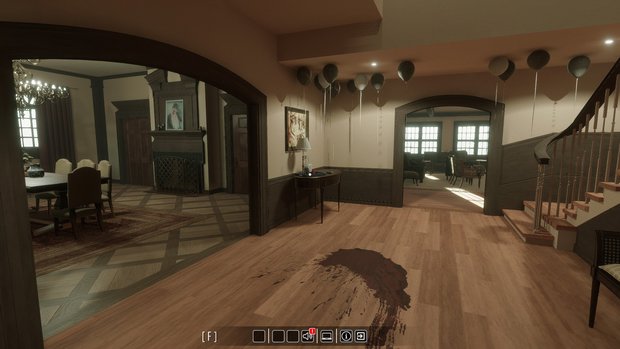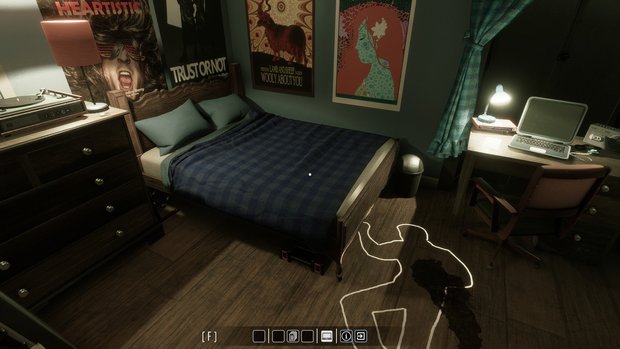Scene Investigators review

- 1 Comment
Compelling crime anthology uncovers enough challenge to test any would-be detective
It must be a difficult job, being a crime scene investigator. Continually walking into a brand new setting and sifting through the detritus of everyday life to find the truly helpful pieces needed to reconstruct a crime. EQ Studios, the indie developers of The Painscreek Killings, provide a taste of what that’s like with Scene Investigators. Rather than tell a single cohesive narrative like its acclaimed predecessor, here players are presented with a series of unlinked locations and a handful of quiz questions to provide context, and are charged with solving robberies, disappearances, B&Es, and even murders. There’s no hand holding here, only the evidence of your own eyes and your ability to weave it together into a logical whole. The cases are hard but the rewards are high for those who persevere, as there’s great satisfaction in solving them.
From the very beginning, Scene Investigators establishes the artificiality of its cases rather than claiming they’re truly representative of real-world criminal investigations. Instead they’re staged as a series of examinations for those wishing to join “the agency.” It’s never made clear if the agency is supposed to be a private detective firm or a governmental branch of some sort. Regardless, in the introductory tutorial, a synthetic-sounding female voice describes how key elements have intentionally been removed from the scenes. It’s left to you to fill in the blanks and deduce what happened with the elements you are given. Such omissions include transcripts of witness interviews, medical examiner reports, and even the bodies, as only taped outlines and usually blood spatter have been left behind.
Each of the nine mysteries operate the same way, dropping you into a single location to examine it. For the most part, the individual cases – or scenarios as the game calls them – are independent of one another. In the tutorial, you’re in a darkened room with a table of collected evidence and a city map on a bulletin board to consult. As you progress through the various cases, the locations generally become larger, with the final scenario being set in a two-story manor with half a dozen different rooms to search.

Within each setting, it’s your job to find the pieces of evidence and make sense of them. Many of these are physical objects that can be picked up and examined in more detail via a rotatable 3D view. There are notes and documents to be read, cell phones whose message histories can be perused, bullet casings, and various other objects of interest. Other clues exist exclusively in the environment themselves and can only be visually inspected in the room, including such things as boot prints, the outlines of bodies, and signs of struggle.
You are immediately thrown into each case with no introductory explanation of what to expect. Instead, a heads-up display can be triggered with the press of a button, from which multiple tabs can be chosen. On rare occasions a bit of preliminary evidence will be provided here, such as a pill bottle or witness statements. Mostly, though, the only usable button is for the exam page for that case. Each scenario provides a series of questions that you must fill out and then submit to receive an evaluation. Such questions run the gamut from the addresses where people were at a given time, to the names of suspects, to counts of assaults, and even math calculations for how much the heirs of a deceased father should receive.
Some of the questions are answered by selecting choices from dropdown lists, while others require typing the answers in. The typing ones can sometimes be problematic, especially where names of suspects are concerned. The game does not always recognize a name even if it has provided a certain form in the first place. For example, one suspect is almost always referred to by a nickname but the game will only accept the proper first name. Fortunately such instances are few and far between, but it did always make me wonder when I got a name question wrong whether I legitimately had the wrong person or if I had typed a version of the name the game hadn’t been programmed to recognize.

Once all questions have been answered, they can then be submitted for evaluation. This tells you how many questions you got right but without indicating which ones, and assigning a letter grade from A to F. You are then free to go back into a case with your current set of answers filled in and change them to try to better your score. I greatly appreciated that my previous entries were remembered, as it made correcting them easier. There’s only one benefit to getting a better grade – aside from the personal satisfaction of gaining a further understanding of each scenario – but it’s an important one, as all cases must be perfectly solved in order to unlock the final case.
Different scenarios are grouped under one of five case files, which players can choose between from the game’s main menu. These include the preliminary trial tutorial, a set of three scenarios under the category “Missing,” another set of three under the category “The 4th Floor,” and then one scenario each for “Bloodbath” and “Hughes Manor Feud.”
Each scenario is independent of the others, save for the ones in the “Missing” case file. These three are interconnected, although that only gradually becomes apparent as the scenes are investigated. This threw me off, especially the second scenario. There was one question in it, pertaining to a suspect, that I simply couldn’t answer. I knew who the person was but not by name. I combed and combed that crime scene but could not find their identity. It was only when I gave up and moved onto the third scenario in that grouping that the name came up. I can’t say with 100% certainty that I didn’t miss the name in question earlier, but I sure couldn’t find it and it felt like a cheat, in a way, having one exam ask a question that, as far as I can tell, is impossible to answer solely within that scenario. Thankfully that was the only time such an apparent cross-answer occurred.

It’s hard to describe what cases are actually like without giving away solutions. A large part of the fun is in putting yourself in the actual role of scene investigator and figuring out how all the pieces fit together. Sometimes the answers to questions can be quite obvious, simply turning up in documents. More often, however, it’s necessary to pull together disparate pieces of information. Without giving away too much, in "Bloodbath," which involves a mass shooting inside a police department, various bullets and shell casings can be discovered. These must be compared to different guns, bullets, and gun maintenance handbooks in the office to determine which bullets go with which weapons. A further layer to this particular mystery, which involves determining if the killer used a standard issue police weapon, involves tracking which of the detectives in the office had which types of weapons by following the scattered narratives available in documents and messages placed around the environment.
In some cases you may want to rely on your intuition to work things out. For example, at one point you must determine pairs of killers and victims. From a strictly storytelling point of view, I had sorted out who these pairs should be, but I initially dismissed my suppositions as there were several pieces of evidence that I felt contradicted or at least called my conclusions into question. After trying several wrong answers, I finally entered my initial story-based conclusions and was surprised to find them correct. The game’s evidence will get you most of the way to the required solutions but sometimes it’s necessary to fill in the gaps based on the characteristics you learn about the suspects. I’m still on the fence as to whether this is a good thing or not in a game that depends so heavily on logically reconstructing the events that happened.
As far as challenge is concerned, the scenarios are all over the place rather than a steady ramping up of difficulty from one case to the next. They’re all demanding, however, so don’t expect to be able to hold all the facts in your head. You’ll definitely want to be taking notes for this one. Scene Investigators provides its own notes window and an in-game camera for taking pictures. The scenes are small enough and quick enough to navigate that I didn’t really use the camera function. The note screen is a translucent window that occupies about a third of the main view screen and overlays the backgrounds (and quiz questions if they’re open). When in a crime scene with the notepad open, the game lets you be in either note-taking mode or room-navigation mode. For example, if you’re using the WASD keys to move about the environment, you obviously can’t use them for typing in the notepad at the same time. The tap of a button toggles between the two and is easy enough, yet I found it strangely unintuitive, so I ended up recording my notes separately from the game itself.

The cases are all well thought out, nicely layered with very few story holes or evidence that can be misconstrued. Even so, there were a few times when I was uncertain of the connections to form and ended up brute-forcing the solutions simply by iterating through the different possible answers. Once I stumbled on the correct ones, it tended to become obvious what the logical thinking was to get there. Of course, that’s easy to say in hindsight. There’s currently no post-investigation summary that lays out the full narrative of each scenario, although the developers have indicated they will be adding something like that in a future update.
All told, it took me eleven hours to play through Scene Investigators. I would usually spend about forty-five to ninety minutes thoroughly poring over each scene and recording notes. Then I’d sit back and work through all the connections for the answers, frequently revisiting specific areas to double check the evidence there. This contemplative part of the case tended to be about half an hour to an hour for me. Generally speaking, the later cases were at the upper end of the time commitment. Part of that was due to them being a bit more complex, but most of it was due to simply having a larger area to search through.
Those eleven hours don’t include the time spent contemplating the game when I wasn’t playing. I found that when I had to step away from a given scenario before finishing it that I’d continue to mull over the evidence I’d found and formulate theories to check the next time I played. This game really stuck with me in that way, and I hugely enjoyed working through all the cases. I found even the easiest of cases to be challenging, and apart from that one suspect question that gave me trouble, all of them are fair.
The crime scenes are presented in a very naturalistic way, with no attempt made to dramatically light them or make them cinematic at all. They’re intended to be functional spaces rather than artistic ones to facilitate getting on with the investigations. While the rooms are presented realistically, the game refrains from graphically depicting gory content such as actual bodies with their brains blown out. However, it does delve into the dark side of humanity with betrayals, murder, prostitution, and drug use.
As with the straightforward visual presentation, a similar restraint applies to the audio, with very few sound effects and voices only factoring in where they would logically have been recorded, such as at the eulogy of a deceased real estate agent, one of the rare instances where you’re given resources not directly connected with the crime scene. Occasionally instrumental music kicks in to build a somber atmosphere, but really even that isn’t needed. I was so focused on solving the cases that I was glad there was so little unnecessary sound to intrude on my thought processes.
Final Verdict
Scene Investigators may be intentionally artificial in its presentation of crime scenes, but the fun it provides is absolutely real. It’s a different sort of game than its predecessor, but The Painscreek Killings was unapologetically challenging and there’s a similar lack of hand holding here, so it will make you think. For the most part the scenarios play fair and are laid out with sufficient evidence to enable you to work through them logically, but with enough room to go with your detective’s gut on occasion. And don’t be surprised if it keeps you thinking even when away from your computer screen. For those who love putting disparate crime pieces together and truly exercising your own little grey cells, this is the game for you.
Hot take
It’s fun to exercise one’s brain cells in Scene Investigators’ assorted collection of engaging mysteries that pull no punches when it comes to challenge and are immensely rewarding as a result.
Pros
- Scenarios are deeply layered and well thought out
- Good variety of cases
- Untangling mysteries with little to no hand holding is very satisfying
- Compelling enough to keep you thinking and theorizing about the facts away from the game
- High interaction density keeps the focus on crime solving
Cons
- Recognition of correct answers can sometimes be a little dodgy
- Wildly varying difficulty instead of a steady ramping up
- Lack of a final summary for each case
Richard played Scene Investigators on PC using a review code provided by the game's publisher.










1 Comment
Want to join the discussion? Leave a comment as guest, sign in or register in our forums.
Thanks for noting your playing times! Looking forward to delve into these mysteries myself, so very handy to know how much I'll have to invest in them ;) Your review pretty much supports what I was expecting!
Reply
Leave a comment